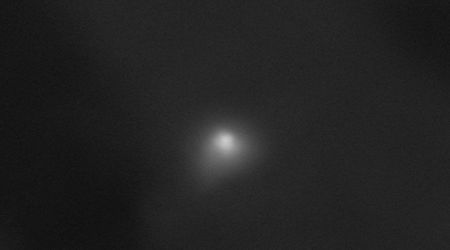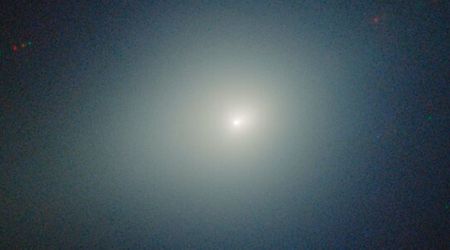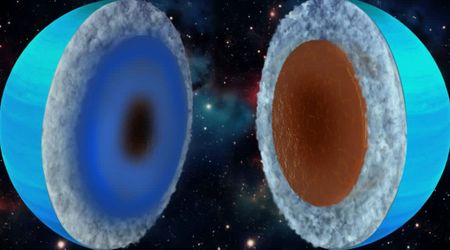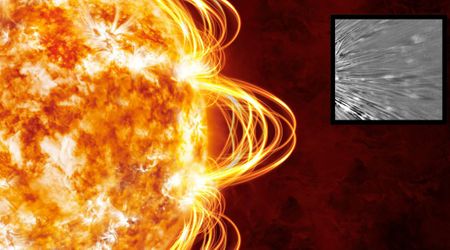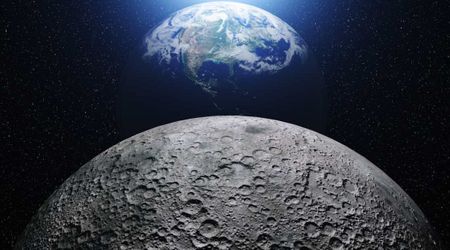The 8 major moon phases
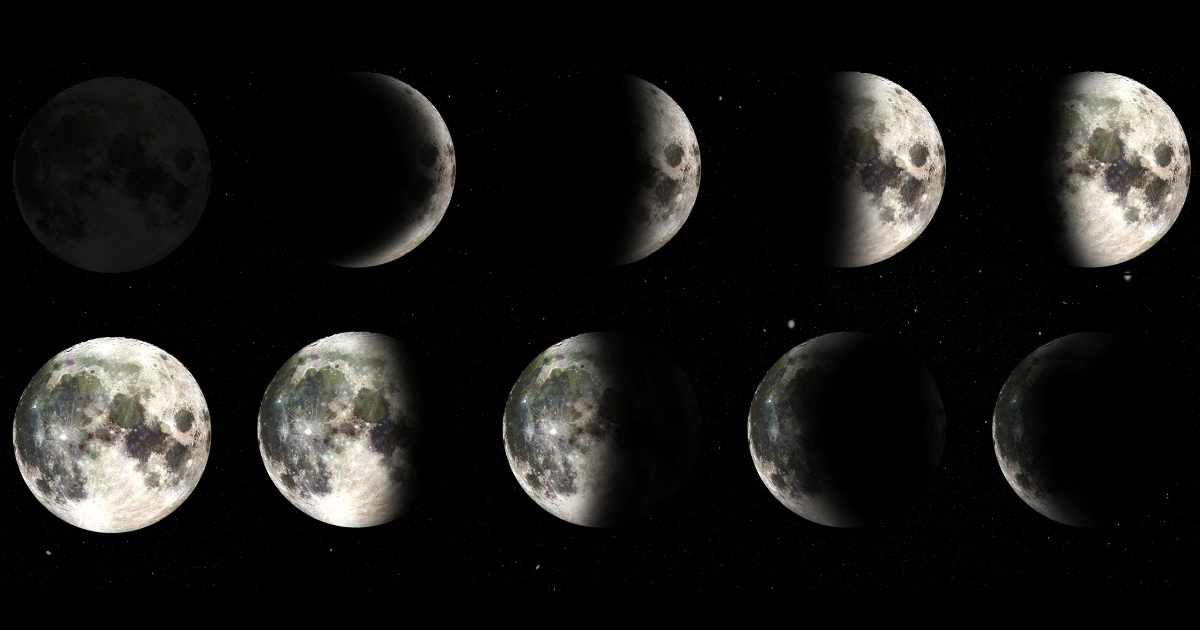
The moon was formed about 4.5 billion years ago when a Mars-sized object that we’ve dubbed “Theia” crashed into Earth during the chaotic early formation of the planetary bodies of our solar system. Some of the debris from this impact was flung out into space, but was close enough to be caught in the New Earth’s gravity. This debris quickly (potentially in as little as hours) coalesced into a single object, which then slowly cooled into what we see as the moon today.
The moon is tidally locked to us, meaning that it takes exactly the same amount of time to rotate on its axis as it does to orbit around the Earth (every 27.322 days). Because of this, we only see one side of the moon while the other is always facing away from the planet, called synchronous rotation.
Today, the moon is an average of 238,855 miles (384,399 km) away from Earth, or about the space that could be occupied by 30 Earths. It also sits at about a 5-degree tilt from the plane that the Earth orbits the Sun. The moon has a day side and a night side, just like the Earth, determined by which half of the moon is facing toward the Sun because it reflects the light from the Sun, as opposed to producing its own light. Since it orbits us as we are orbiting the Sun, we see the moon go through phases in which parts of the moon’s face are illuminated by the Sun.
While the Sun always illuminates half of the moon, we often don’t see the full half since we are at the center of the moon’s orbit. We see eight specific phases as the moon travels through its orbit, and our view of the illuminated side changes.
What Are the 8 Major Moon Phases?
1 - New Moon
This occurs when the moon is directly between us and the Sun, blocking the light from the Sun and therefore being in shadow, invisible to us. The illuminated/ day side of the moon faces the Sun and its shadowed night side faces the Earth.
The moon is in the same part of the sky as the Sun, rising and setting with it, meaning it's also up during the day. In the clock analogy, the new moon corresponds to the 12 o'clock noon/ midnight position. If all three line up perfectly, this phase produces a solar eclipse.
Learn more about the new moon phase
2 - Waxing Crescent
As the moon moves in its orbit, a small sliver of its surface becomes visible from here on Earth. As the moon continues its orbit around us, more and more of it will be illuminated each night as the dayside comes further and further into view. In the clock analogy, the moon or tip of the clock hand moves away from the twelve counterclockwise toward the nine.
3 - First Quarter
When the moon is a quarter of the way through its orbit, at the nine in the clock analogy, we see half of its illuminated/ day side. Many call it a half moon since it seems to be half of our full moon, but we're actually just seeing a quarter of the moon, half of the illuminated half. In the first quarter, the moon rises around noon and sets around midnight, staying high in the sky in the evening.
4 - Waxing Gibbous
As the moon continues its orbit around us, more of its illuminated side faces us, growing from the first quarter to the entire illuminated side. In the clock analogy, the moon moves counterclockwise from the nine to the six.
5 - Full Moon
The three astronomical bodies line up again, but this time, with the Earth in the middle. This is the Sun's illumination of the entire day side of the moon, or as close as we can get. A full moon rises around sunset and sets around sunrise since it is opposite the Sun as viewed from Earth. In the clock analogy, the moon or the tip of the clock hand is at six. The full moons have special names and have had various impacts on animals and humans. If all three line up perfectly, this phase produces a lunar eclipse.

6 - Waning Gibbous
As the moon orbits back around on the other side of the Earth, it slowly disappears as the angle from the Sun's light goes through the same motions as before, but in reverse, carrying the illuminated side away from our view. The moon appears less and less full and rises later and later each night. In the clock analogy, the moon or the tip of the clock hand moves counterclockwise from the six to the three.
7 - Last/ Third Quarter
Just like the First Quarter, the moon is lined up so that half of the illuminated side of the moon is visible from Earth. In the clock analogy, the moon or the tip of the clock hand is at three. Again, it rises around midnight and sets around noon.
8 - Waning Crescent
As the moon makes its final steps back to where we started, more and more of the moon disappears, eventually leaving only a tiny sliver of the illuminated moon visible from Earth before it lines back up and disappears for New Moon. In the clock analogy, the waning crescent is the time in which the moon on the tip of the clock hand moves counterclockwise from the three to the twelve.
And then the cycle repeats, starting with New Moon again. In total, it takes 29.5 days to change from new moon to new moon.
Sometimes we see more of the moon
It's important to note that the moon's orbit is elliptical, not perfectly circular, but rather more of an oval shape. Its distance and speed change slightly throughout the month. Due to these factors, frequent moon observers will notice that the moon appears to wobble a little, twisting, nodding, and rolling slightly so that we can catch glimpses of the far side of it. This is known as libration. When the moon is at its closest to Earth and moving the quickest along its orbit, it itself doesn't rotate quite fast enough to keep entirely the same side toward the Earth, so we get to see a tiny bit more of the eastern side of the moon. In the opposite situation, when the moon is farthest from Earth and orbiting at its slowest, its rotation gets a little ahead, and we see a sliver more of its western side.
The 5-degree tilt also causes the moon to apparently nod (as if it were indicating “yes”) since the tilt causes it to sometimes appear above Earth's northern hemisphere and sometimes below Earth's southern hemisphere. This provides glimpses of small parts of the northern and southern hemispheres of the moon that we wouldn't see if there were no tilt. As that 5-degree tilt is also combined with Earth's 23.5-degree tilt on its axis, the moon appears to tilt back and forth like a metronome since it's almost like we're standing sideways on a ramp.
In addition, sometimes during the crescent phases, we still dimly see the darkened, unilluminated side of the moon. This is caused by the Sun's light reflecting off Earth's surface onto the moon. An observer on the moon would see the Earth as nearly full at this point in the cycle, which can reflect enough light from the Sun off the Earth (called “earthshine”) to dimly illuminate the unilluminated side of the Moon.
We already mentioned that the moon can be seen during the day. At any phase besides the new moon and full moon, but particularly during the first and last quarter phases, the moon is high enough above the horizon and at about 90 degrees from the Sun in the sky, which helps make the Sun's reflected light bright enough. Daytime gibbous phases can only be glimpsed just before the Sun sets, while crescent through quarter phases are high during the day.

Tracking the phases
The phases of the moon have been well-known to humanity since ancient times and have impacted our calendars, helping us keep track of seasons and related cultural events. The phases continue to be tracked today, and it is very easy to find moon phase calendars and calculators for the year.
You can also track the phases of the moon yourself in an observation journal or make a moon phases calendar and calculator to keep track. You can also experience the phases of the moon with a few common household items, like a ball on a stick and a light source. Every year, communities from around the world celebrate the moon on International Observe the Moon Night in October. This year it will be celebrated on October 4, 2025. Check to see how your community is participating.
It is very easy to observe the moon with your naked eye, as it is the closest astronomical object to us. Binoculars provide more detail and texture, bringing craters and mountain ridges into focus with even 7x magnification, but 10 to 15x provides much more detail. A small telescope can also provide amazing detail, making it too big to see all at once. Observing at the terminator (the line between the nightside and the dayside) is often recommended, and be aware that the full moon can be so bright that it can actually make observation difficult. There are moon filters for telescopes to help reduce this.
Observe using all these methods in different phases and times of year to see the moon in immense detail. Keeping track of the moon is also vitally important in scheduling stargazing trips, as the full moon will drown out more stars. New Moon provides the best conditions for stargazing, but the smaller the better is usually recommended to see the most stars, planets, and other astronomical objects.

Conclusion
We see the moon wax and wane in a familiar cycle every month throughout the year. The familiar face of the moon increases and decreases with sometimes dramatic effect, especially if you haven't noticed it for a bit. These phases are well-documented and tracked by professionals, but you can also track them yourself through your own observations.
So, the next time you look at the moon, make a note of it. Is it a crescent, quarter, gibbous, or full moon? Is it waxing or waning? Use calendars or your own observations to keep track, especially when planning stargazing trips



